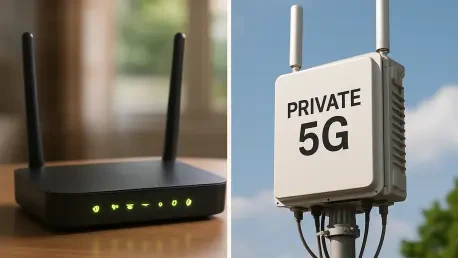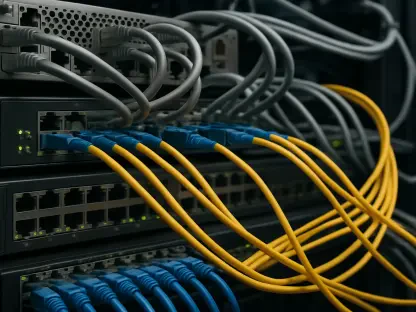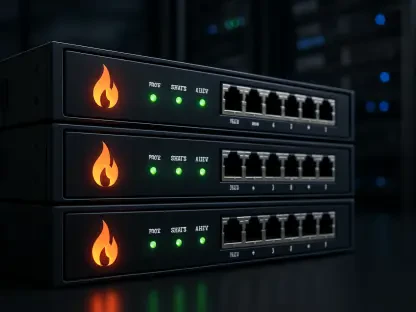In a world where seamless connectivity is no longer a luxury but a necessity, enterprises are reevaluating their technological foundations to keep pace with escalating demands for speed, security, and scalability, especially as industries like manufacturing, transportation, and mining pivot away from traditional Wi-Fi networks toward private 5G solutions. This shift isn’t merely a trend but a strategic response to the limitations of Wi-Fi in high-stakes environments where downtime or data breaches can cost millions. Private 5G, with its promise of ultra-low latency and robust reliability, is emerging as a game-changer, offering a unified network that can handle the complexities of modern operational technology. As digital transformation accelerates, understanding this transition becomes critical for companies aiming to maintain a competitive edge. The driving forces behind this change reveal a deeper story of innovation, economics, and long-term planning in enterprise connectivity strategies.
The Technological Edge of Private 5G
The allure of private 5G lies in its superior technical capabilities, which address many of the shortcomings inherent in even the most advanced Wi-Fi systems, such as Wi-Fi 7. Designed to support mission-critical applications, private 5G delivers ultra-low latency and carrier-grade reliability, often achieving what industry insiders call “five-nines” uptime—a benchmark that ensures near-constant availability. This is particularly vital in heavy industries where real-time data transmission can mean the difference between operational success and costly failures. Unlike Wi-Fi, which often requires a dense array of access points to maintain coverage in sprawling facilities like factories or ports, private 5G provides a single, cohesive network layer. This streamlined architecture not only simplifies maintenance but also enhances scalability, allowing businesses to expand operations without the burden of overhauling their connectivity infrastructure. Such advantages make it clear why sectors with high-stakes environments are prioritizing this technology over traditional options.
Beyond performance metrics, private 5G offers a level of security and integration that Wi-Fi struggles to match in demanding settings. Enterprises operating in fields like manufacturing or logistics often rely on AI-driven systems and cloud-native environments, which require robust and secure connectivity to function effectively. Private 5G networks are built to integrate seamlessly with these advanced technologies, providing end-to-end encryption and reducing vulnerabilities that can arise from fragmented Wi-Fi setups. Additionally, the ability of 5G to support a massive number of connected devices simultaneously ensures that businesses can adopt IoT solutions at scale without fear of network congestion. This technological harmony positions private 5G as not just a faster alternative, but as a foundational platform for the next wave of industrial innovation. The focus on reliability and compatibility underscores why many companies view this shift as a necessary step toward future-proofing their operations.
Economic and Strategic Advantages
When evaluating the financial implications, the transition to private 5G reveals compelling long-term benefits despite its initially higher upfront costs compared to Wi-Fi hardware. A deeper look at the total cost of ownership (TCO) shows that private 5G often proves more economical over time by reducing the need for extensive access point networks and minimizing fragmented management efforts. Enterprises can consolidate their connectivity into a single, efficient system, which streamlines security protocols and cuts down on operational overhead. This consolidation also translates into a stronger return on investment (ROI) as businesses leverage a unified network to drive digital transformation initiatives. By aligning connectivity with broader strategic goals, companies position themselves to achieve greater operational efficiency and financial gains, making the case for private 5G a matter of smart economics rather than just technological preference.
Strategically, adopting private 5G equips enterprises with a competitive advantage in an increasingly digital marketplace. The ability to build cohesive digital strategies on a reliable network foundation allows businesses to innovate faster and respond more effectively to market demands. For instance, industries that depend on real-time analytics or automated processes gain significant agility when supported by a network that minimizes latency and maximizes uptime. Moreover, the scalability of private 5G ensures that companies can grow without being constrained by outdated infrastructure, a limitation often encountered with Wi-Fi systems in large-scale deployments. This forward-thinking approach not only enhances current operations but also prepares enterprises for emerging technologies and market shifts. As a result, the strategic pivot to private 5G is seen as an investment in both present stability and future adaptability, reinforcing its appeal across diverse sectors.
Evolving Market Dynamics and Challenges
On the vendor landscape, the private 5G market is buzzing with activity as major players and innovative startups push the boundaries of what’s possible. Companies like Ericsson and Nokia are leading the charge with cutting-edge solutions tailored for enterprise needs, such as secure remote access systems that eliminate the reliance on VPNs. Meanwhile, smaller firms are finding success by focusing on niche applications, adding diversity to an already competitive field. However, this rapid development comes with hurdles, including market confusion over what truly constitutes a private 5G network and inconsistencies in vendor offerings. Spectrum licensing and deployment complexities further complicate adoption, while even large tech giants have stepped back after underestimating operational challenges. These dynamics highlight a market still in flux, where innovation and obstacles coexist, shaping the pace at which enterprises can fully embrace this technology.
Despite these challenges, the trajectory for private 5G remains promising as consumer adoption begins to align with enterprise trends, albeit at a slower pace. Wi-Fi’s deep-rooted presence in homes and public spaces, coupled with its affordability in devices like laptops, keeps it relevant for now. Yet, advancements such as embedded 5G modems in premium devices and a growing acceptance of wireless-first lifestyles among younger demographics signal a gradual shift. Over time, the friction of toggling between Wi-Fi and 5G networks is expected to diminish, paving the way for broader acceptance. Enterprises that moved early on private 5G found themselves ahead of the curve, gaining efficiencies while others grappled with legacy systems. This evolving landscape underscores the importance of strategic timing, as vendors work through deployment issues and market definitions become clearer, setting the stage for wider integration across both industrial and consumer spheres.
Looking Ahead to Connectivity Dominance
Reflecting on the journey, the shift toward private 5G marks a pivotal moment for enterprises seeking to redefine their connectivity frameworks. As industries adopt this technology, they navigate initial costs and market uncertainties to unlock unparalleled reliability and scalability. The path isn’t without obstacles, but the commitment to overcoming them lays a strong foundation for digital transformation. Moving forward, businesses should prioritize assessing their network needs against the backdrop of 5G’s capabilities, exploring partnerships with trusted vendors to ease deployment. Investing in training and infrastructure now can position companies to capitalize on emerging opportunities as 5G continues to evolve into the dominant connectivity standard. Additionally, staying informed about regulatory changes and spectrum availability will be crucial for seamless integration. By taking proactive steps, enterprises can ensure they remain agile and competitive in a landscape where connectivity is the cornerstone of innovation.









